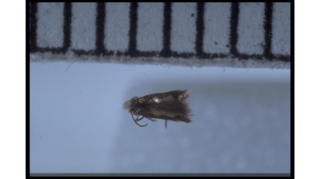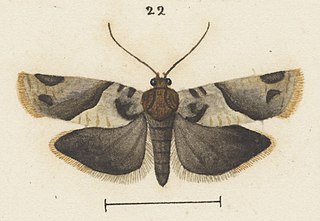
Wells National Estuarine Research Reserve, also known as Wells Reserve, is a National Estuarine Research Reserve located in Wells, Maine.

The Archipini are a tribe of tortrix moths. Since many genera of these are not yet assigned to tribes, the genus list presented here is provisional.

Stigmella aigialeia is a moth of the family Nepticulidae. It is endemic to New Zealand and can be found on both the North and South Islands. The larvae of this species are leaf miners and are known to feed on the leaves of Plagianthus divaricatus. Larvae have been recorded as feeding in April, May and September. They pupate in leaf litter on the ground under their host plant. Adults of this have been observed on the wing in January, February, September and October, in coastal locations particularly in the preferred habitat of its host plant, that is salt marshes and sandbanks.

Epiblema sticticana is a species of moth of the family Tortricidae described by Philogène Auguste Joseph Duponchel in 1842.

Isotrias rectifasciana, the hedge shade, is a species of moth of the family Tortricidae found in Asia and Europe. The moth was first described by the English entomologist, Adrian Hardy Haworth in 1811.

Scrobipalpa obsoletella, the summer groundling, is a moth of the family Gelechiidae. It is found in most of Europe, Turkey, the Caucasus, from Iran to Asian Russia (Transbaikal) and Mongolia. It has also been recorded from New Zealand, South Africa and North America, where it is probably an introduced species. The habitat consists of coastal salt marshes and sandy beaches.

Aethes francillana, the long-barred yellow conch, is a moth of the family Tortricidae. It was described by Johan Christian Fabricius in 1794. It is found in almost all of Europe, from north-western Africa to Afghanistan and Dzungarian Alatau in Central Asia. It is also found in the Ural Mountains, Kazakhstan, Tajikistan, western Siberia, Asia Minor and Iran. The habitat consists of rough grassland, particularly chalk downland and coastal areas.

Phalonidia affinitana, the large saltmarsh conch or large saltmarsh bell, is a species of moth of the family Tortricidae, the subfamily Tortricinae, and the tribe Cochylini. It is found in China, Japan, Korea, Russia and most of Europe. Its habitat consists of salt marshes.

Ctenopseustis fraterna, the brownheaded leafroller or the rusty ponga leaf-tyer, is a species of moth of the family Tortricidae. It is found in New Zealand, where it has been recorded from the North Island only. The common name is also used for the related species Ctenopseustis herana and Ctenopseustis obliquana.
Ctenopseustis servana is a species of moth of the family Tortricidae. It is found in New Zealand, where it has been recorded from the North Island and the Three Kings Islands.

Epichorista lindsayi is a species of moth in the family Tortricidae. It is endemic to New Zealand. This species is classified as Nationally Endangered by the Department of Conservation.

Epichorista tenebrosa is a species of moth in the family Tortricidae. This species is endemic to New Zealand. It is found in Otago and has been collected in tussock grassland habitats. It is a late autumn emerging moth and adults are on the wing in February. It is classified as "At Risk, Relict'" by the Department of Conservation.
Eurythecta eremana is a species of moth of the family Tortricidae. It was first described by Edward Meyrick in 1884. is found in New Zealand. The habitat consists of swampy areas.

Eurythecta loxias is a species of moth of the family Tortricidae. It is found in New Zealand.

Eurythecta phaeoxyla is a species of moth of the family Tortricidae. It was described by Edward Meyrick in 1938. It is endemic to New Zealand and has been observed in the Canterbury and Otago regions. The preferred habitat of this species is alpine swampy areas. The larvae feed on herbs and adults are on the wing in February.

Eurythecta robusta is a species of moth in the family Tortricidae. This species is endemic to New Zealand. It is classified as "At Risk, Naturally Uncommon" by the Department of Conservation.

Eurythecta zelaea is a species of moth of the family Tortricidae. It is found in New Zealand. It is endemic to dry herbfields in Otago and Canterbury.

Acleris lorquiniana, the marsh button, is a species of moth of the family Tortricidae. It is found in Iran and central and northern Europe, where it has been recorded from Great Britain, France, Belgium, the Netherlands, Germany, Denmark, Austria, Switzerland, the Czech Republic, Slovakia, Poland, Romania, Hungary, Sweden, Finland, the Baltic region and Russia. The habitat consists of damp fenland.

Acleris aspersana, the ginger button, is a species of moth of the family Tortricidae. It is found in Europe, where it has been recorded from Ireland, Great Britain, France, the Benelux, Germany, Denmark, Austria, Switzerland, Italy, the Czech Republic, Slovakia, Slovenia, Croatia, Hungary, Bulgaria, Romania, Poland, Norway, Sweden, Finland, the Baltic region and Russia. It is also found in the Near East and the eastern Palearctic realm. Their habitat consists of meadows and forest edges.

Paranotoreas fulva is a species of moth in the family Geometridae. This species is endemic to New Zealand and is found in the southern half of the South Island. The preferred habitat of this species are the salt pans of Otago, the mountainous grassland areas in South Canterbury and Otago and the glacial outwash terraces south of Tekapo. The larvae feed on Atriplex buchananii and Plantago coronopus. Adults are day flying and have been recorded as being on the wing in March, October and December. P. fulva is classified as "At Risk, Relict" by the Department of Conservation.


















